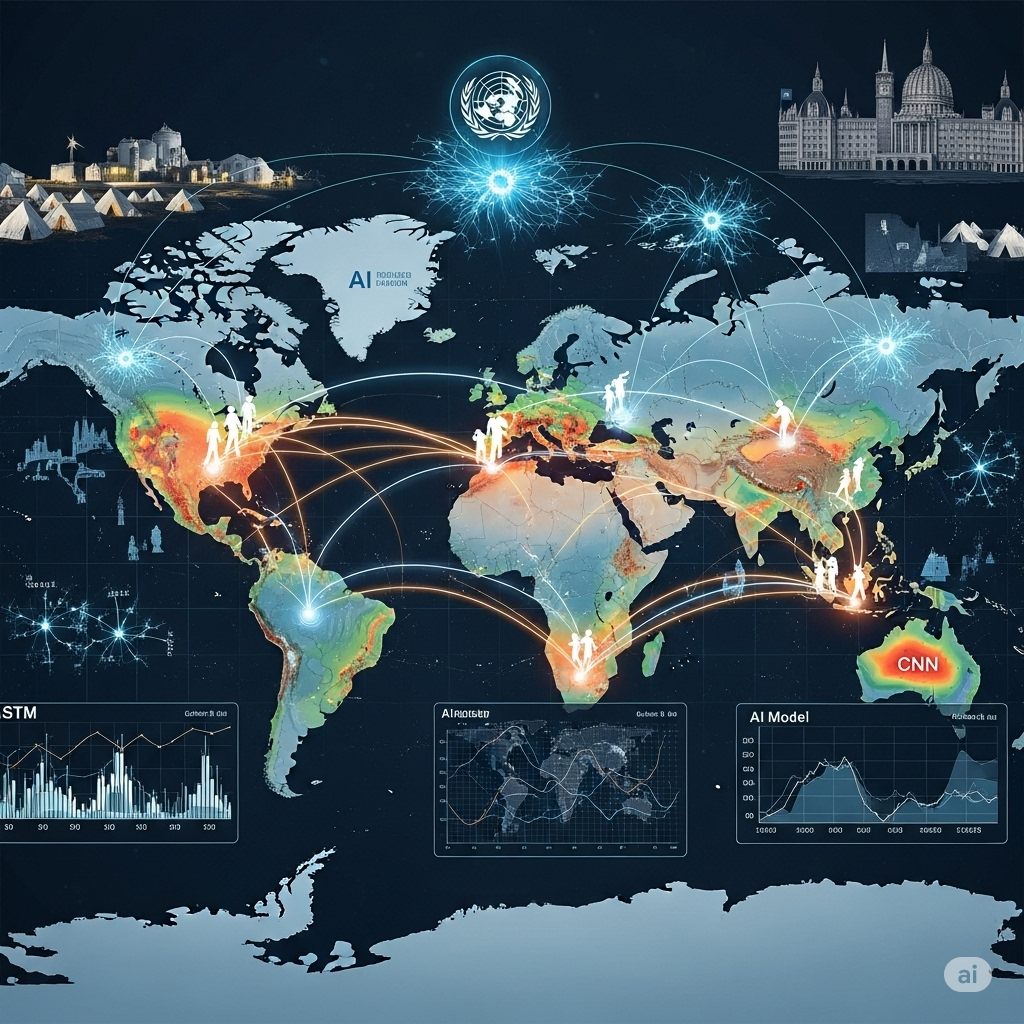
- AI, when coupled with Data Analytics, offers a powerful toolkit to process vast volumes of unstructured data, predict future flows, and understand the downstream impacts on host countries and regions.
- AI-driven forecasts are now embedded in regional policy planning, electoral risk modelling, and intelligence analysis.
- Agent-Based Simulation is a decentralised model where refugees are treated as individual agents with probabilistic rules.
- Moving forward, global institutions must ensure that AI models are ethical, inclusive, and serve humanitarian goals.
Introduction
The global refugee crisis has become one of the defining humanitarian challenges of our time. Wars, ethnic violence, climate change, and political instability are forcing millions to leave their homes, seeking safety and stability across borders. According to the United Nations High Commissioner for Refugees (UNHCR), the number of forcibly displaced individuals surpassed 100 million by 2023.
Traditional methods of monitoring refugee flows—based on manual census, interviews, and border reports—are insufficient in today’s fast-changing environment. Artificial Intelligence (AI), when coupled with Data Analytics, offers a powerful toolkit to process vast volumes of unstructured data, predict future flows, and understand the downstream impacts on host countries and regions.
This article delves into the technical capabilities of AI models used for refugee analysis, the mathematical principles behind them, and the broader geopolitical implications that stem from large-scale human migration.
The Refugee Data Ecosystem
Analysing refugee movements requires a diverse array of data sources. The datasets used are often fragmented, high-dimensional, and time-sensitive. AI models must integrate data from:
- UNHCR and national databases: Structured population and refugee status data.
- Satellite imagery (NASA, ESA): Visual tracking of camp formations, environmental degradation.
- Social media (Twitter, Facebook): Real-time sentiment analysis, public discourse, geo-tagged distress signals.
- ACLED (Armed Conflict Location & Event Data): Spatiotemporal mapping of conflict zones.
- Climate data (NOAA): Correlating extreme weather and forced displacements.
- Immigration portals and visa processing data.
Through advanced preprocessing (e.g., data cleaning, interpolation, geocoding), these inputs are transformed into structured formats suitable for AI consumption.
AI Models and Mathematical Foundations
AI models used in refugee analysis span several categories, each with a mathematical backbone:
A. Time Series Forecasting (LSTM, ARIMA, Prophet)
These models predict future refugee flows based on historical data. LSTM neural networks are especially effective:
h_t = σ(W_hx * x_t + W_hh * h_{t-1} + b_h)
Where h_t is the hidden state, x_t is the input at time t, W are weights, and b is bias. These models capture time dependencies, seasonality, and conflict-driven spikes.
B. Convolutional Neural Networks (CNN)
Used to analyse satellite images, CNNs detect formation and expansion of refugee camps. A convolution operation applies kernels to extract features:
Y(i,j) = Σ_m Σ_n X(i+m, j+n) * K(m,n)
Where X is the input image and K is the filter/kernel.
C. Natural Language Processing (NLP)
BERT-based models perform Named Entity Recognition and sentiment classification on tweets, news, and blogs. The models use attention mechanisms to weigh important phrases.
D. Agent-Based Simulation
These are decentralised models where refugees are treated as individual agents with probabilistic rules. Agents “choose” paths based on cost, risk, family presence, and access to services.
Political Impact and Ethical Dimensions
The consequences of mass migration ripple far beyond borders. AI-driven forecasts are now embedded in regional policy planning, electoral risk modelling, and intelligence analysis. However, ethical concerns remain:
– Privacy: Use of social media data must be anonymised.
– Bias: Models trained on biased news or historical data may reinforce stereotypes.
– Transparency: Black-box models must be explainable in policymaking contexts.
– Manipulation: Risk of using AI forecasts to support anti-immigration rhetoric.
For instance, during the 2015 refugee crisis, AI tools helped the EU anticipate the load on border control and allocate humanitarian resources. Yet, public discourse—modelled by sentiment classifiers—also revealed increasing polarisation in voter bases, aiding the rise of nationalist parties in Hungary and Austria.
| Case Study: Rohingya Crisis and AI Applications |
| One of the most significant refugee crises in recent history involves the Rohingya population fleeing Myanmar. Since 2017, more than 700,000 Rohingya refugees have crossed into neighbouring Bangladesh due to ethnic persecution. AI and satellite imaging have played critical roles in documenting the extent of destruction in Rakhine state and monitoring refugee camp growth in Cox’s Bazar, one of the world’s largest refugee camps. Machine learning models trained on temporal satellite data revealed deforestation patterns and the rapid expansion of shelter zones, aiding in planning water and sanitation infrastructure. In addition, crowd-sourced GPS data from NGOs, combined with AI-powered simulations, helped forecast internal migration patterns within Bangladesh during monsoon flooding, which often displaced the displaced once more. Sentiment analysis tools also tracked global outrage and calls for intervention by analysing trending hashtags like #SaveRohingya, helping international agencies prioritise response in both media and diplomatic corridors. Mathematical Optimisation for Aid Distribution AI is not only useful in predicting migration, but also in optimising aid delivery. Linear programming and mixed-integer programming models have been applied to determine optimal resource allocation in refugee camps. For example: Minimize: Z = Σ C_ij * X_ij Subject to: Σ X_ij ≤ Supply_i and Σ X_ij ≥ Demand_j Where: – X_ij = quantity of resource i allocated to location j – C_ij = cost of transporting resource i to location j These models, when integrated into cloud dashboards, allow governments and NGOs to simulate logistics before actual distribution. Combined with geolocation data and transportation constraints, these systems improve operational efficiency and reduce waste during crises. |
AI and International Collaboration
The global nature of refugee crises requires cross-border collaboration. AI models often work best when trained on combined datasets from multiple nations. Organisations like UN Global Pulse and the International Organisation for Migration (IOM) promote open-data ecosystems where anonymised migration data can be securely shared for model training.
For example, an LSTM model trained jointly on Syrian, Afghan, and South Sudanese migration data performs better in recognising seasonality and policy-driven effects (e.g., sudden border closures or visa policy changes). Cross-border datasets also enable federated learning models, preserving privacy while benefiting from global data variety.
AI-enhanced diplomacy is also emerging—where political risk models assess how refugee flows may impact bilateral ties or humanitarian obligations under international law.
The Road Ahead
AI has become indispensable in understanding, predicting, and responding to forced human migration. Through time-series forecasting, satellite imagery analysis, sentiment mining, and agent-based simulations, AI offers a multidimensional view of refugee dynamics—illuminating not only where people are moving, but why, and under what conditions.
As we look ahead, the evolution of these technologies promises even greater impact. Emerging applications such as drone-assisted surveillance, wearable devices for real-time humanitarian relief, and large-scale language models capable of translating distress signals in local dialects could revolutionise how displacement is managed on the ground. However, with increased capabilities comes heightened responsibility.
Ethical deployment must remain a central pillar. Ensuring transparency in model assumptions, explainability in outputs, and fairness in decision-making is essential to prevent harm and bias. AI must not be used merely to monitor or manage migration, but to uphold human dignity and enhance the speed, intelligence, and compassion of humanitarian responses.
From refugee camps in the Middle East to the borders of Europe and the legislative tables of global powers, AI is quietly yet powerfully shaping the future of migration governance. But refugees are not data points—they are human beings with stories, rights, and hopes. The true potential of AI lies in amplifying this understanding and helping the world respond with empathy, precision, and justice.
References and Tools Used
- UNHCR Refugee Data Portal: https://data.unhcr.org/
- ACLED Conflict Data: https://acleddata.com/
- Facebook Prophet: https://facebook.github.io/prophet/
- Google Earth Engine for Satellite AI
- Huggingface Transformers for NLP
- QGIS for Geospatial Visualisation
Divyanka Tandon holds an M.Tech in Data Analytics from BITS Pilani. With a strong foundation in technology and data interpretation, her work focuses on geopolitical risk analysis and writing articles that make sense of global and national data, trends, and their underlying causes. Views expressed are the author’s own.

It’s surreal to think AI can help us understand something as complex as refugee movements. I always thought it was just too chaotic to track properly. Makes you wonder what other big global issues AI could help with. Good read!
On one hand, using AI to get better data on refugees sounds like it could really help with aid and planning. But on the other, it also feels a bit… ‘big brother’-ish? Like, who has access to all this data and how is it really being used? This is something to think about, I guess. Still, a cool concept.